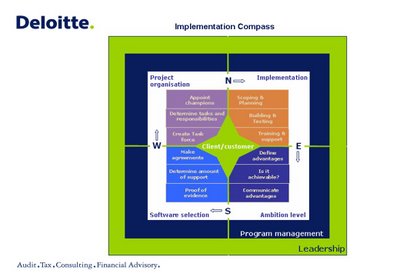I've been blog-tagged!
Well, last week I received an email from Frank Buytendijk. What could it be? A new million-dollar lead for our Hyperion Practice? He won the lottery and wanted to share a million or so with us? Nothing of that, it was something more shocking. I had been tagged by Frank. Blog-tagged to be precise. I had never heard of blog-tagging before but a quick look at the Wikipedia learned me the first definition (in the Wikipedia) was from september 2006.
The idea is, just like at cocktail parties to share something that most people wouldn't know about you. I tried to track back the line to the first blogger who started this intiatieve. I found out it was Jeff Pulver. However it turned out not to be that easy to track whole line. A short investigation produced the following result.
The link from Frank Buytendijk (Hyperion) goes back to Andy Bitterer from Gartner. Andy received his invitation from Dave Yockelson who is a member from the META Group. From there on I lost track. However a nice overview of bloggers who played this game can be found at The Blog Tag Tree. Unfortunately the list is not up to date.
Okay, now let's start with a list of five things about our CPM-practitioners most people don't know (or don't want to know ha ha ha). You can use this photo to obtain a visual of the cpm-practitioner or just have a look at his blogger profile.
- Let's first start with myself. Before I joined Deloitte I was in the Graduate Programe Economics & Finance at the Universitat Pompeu Fabra. As you all know, studying cost a lot of money so I needed a job on the side! I applied for a job at the Baja Beach Club. What can I say about it? Just check the link and you will find out why it's so hilarious. In the picture mentioned before I am the guy to the left on the lower row.
- Let's move on to Bart van Onzen. Funny thing about Bart is he likes R&B clubs, however he doesn't like the R&B music itself. So it's for each of you to decide what he likes. It has something to do with girls (sorry Bart). Bart is the fourth guy from the left at the upper row.
- Rutger van den Berg has a couple of funny things, however, I will not mention all of them. Some things are not really professional (or I am wrong Rutger ha ha ha). When Rutger was a student he wore a mullet (long hair till his shoulders - Business upfront, Party in the Back!). Before Rutger was a student he worked for the Secret Service (back then he was just fifteen). He retired from active duty at the age of twenty. The reason he retired was his addiction to chocolate, which can be a pain in the ass during a stake-out! Rutger is the first guy from the right at the upper row.
- Now we are talking about addictions, it's time to introduce Damien Wiegman. Damien always looks like he just came back from holiday. Completely (well, completely I don't know actually!) tanned and always ready for a party. The tanning center is really happy to have him as a customer. Damien addiction is for sure the tanning studio. Damien is the second guy from the left at the lower row. As you can see on the picture he took a head-shot during the paintball session.
- Last but not least is Edwin van den Broek. I know Edwin from the time I just started at Deloitte. At that time he was driving an small car (Opel Corsa), he was working at big project at Delta Nuts (a energy company in Middelburg) and living in Utrecht. He was renovating his house so he decided to drive back and forward each day. At night time he was renovating his house and with a few hours sleep he went back to Middelburg. So Edwin was driving a little bit less than 400 km each day. You can check out his route description at Google Maps. Edwin is the guy to the left at the lower row.
So enough funny details about our CPM-practitioners. Now it's my time to tag some bloggers.
Okay guys: TAG! You're it now...





